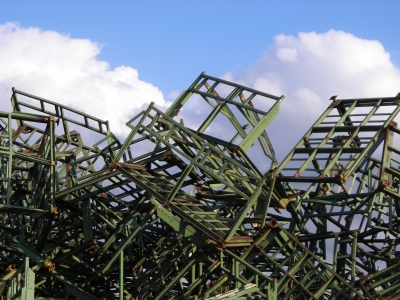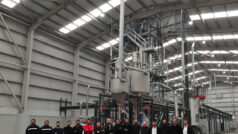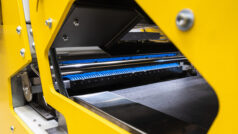There seems to be at least a little bit of relief for the suffering ferrous metals industry, according to the president of BIR’s ferrous metals division, William Schmiedel of Sims Metal Management. He says the industry “seems to be bumping along the bottom and looking for a recovery”. The market seems to be more stable than one year ago, but there are still problems to face, especially with China. Schmiedel points out that in June, China’s steel export was the second-largest monthly total on record. “The continuing Chinese exportation of their excess steel production will keep a lid on steel and ferrous scrap prices,” Schmiedel says. And although more and more governments are putting up barriers to entry for Chinese steel, Schmiedel doubts that this will solve the problem. He points out that China itself has to change in terms of steel production.
Although the Chinese government has announced its intention to cut its steel making capacities by 45 million tonnes, so far there have been more restarts than closures. However, Schmiedel points out that the main problem in China is not the capacity but the actual steel production. With 1.1 to 1.2 billion tonnes of capacity, cuts will have no influence on the production, which totalled 800 million tonnes in 2015. “So we need three things to happen: the first is rationalised steel production in China; the second is a major reduction in the manipulation of coding and classification; and the third, and the most likely of these three to happen, is a major capital infusion by Beijing into the Chinese infrastructure, as this would help absorb the excess steel production,” Schmiedel concludes.
For Japan, Hisatoshi Kojo from Metz Corporation points out that June was a more stable month in terms of prices. After the Brexit referendum, the Japanese currency grew stronger, which led to a price decline in the steel scrap market. But after the announcement of a new British prime minister and elections in Japan, the market regained its composure. Kojo points out that the Japanese steel mills, especially those operating electric arc furnaces, have continued to implement production cuts. However, there are no surplus capacities for export because most scrap dealers are keeping a minimum inventory to avoid further losses. According to Kojo, the Japanese market also has to fear more activities from Vietnamese steel mills since the country has finally issued import licenses for 2016. “Taking the above into consideration, it is believed that the Japanese scrap export market has hit rock-bottom and is expected to trend upwards again towards the autumn, although no upsurge in demand can be anticipated from Korea and Taiwan. Furthermore, developments in China remain something of an unknown quantity,” he says.
Meanwhile, Indian ferrous scrap imports were 20 per cent higher than last year, Zain Nathani of the Nathani Group of companies explains. The largest exporter to India was the USA, which accounted for approximately 17 per cent of the total. However, this did not have a positive impact on the domestic steel situation. As Nathani points out, the demand for finished steels remained very poor and banks are wary of lending to steel mills. Since there is not enough demand in India, suppliers have started to sell to other markets such as Bangladesh and Pakistan. “In the near term, the only hope for domestic steel producers is for normal rainfall levels during the current monsoon season and for the economy to receive a boost, resulting in a pick-up in infrastructure projects and a revival in the real estate and auto sectors,” Nathani concludes.
Very little good news is coming from Russia and Ukraine. According to Andrey Moiseenko of Ukrmet, most steel mills in Russia cut back production in July. Collections are normal, but suffering from the hot weather and the grain season. Moiseenko points out that with increasing freight rates and a strong rouble, export is quite a challenging business right now. The low level of export also applies to Ukraine. However, the government has imposed a 30-euro export tax and all other regulations in this field have been cancelled. This would lead to a 30-euro per tonne advantage for local steel mills, Moiseenko explains, but not all mills will risk putting extra pressure on the price, especially with collections already being low.
After a strong first quarter, the US market saw a second quarter in which supply exceeded demand, George Adams of SA Recycling says. The trend was accompanied by a shrinking export market, leading to lower prices. “That weakness is now the norm in the US market as mill downtime and reduced summer demand has pushed the market balance into oversupply. In addition, the strong dollar is attracting cheaper European scrap into the US market, further eroding US scrap prices. That trend should continue into August unless export shows any new signs of life,” Adams summarises.
For Europe, Tom Bird of Mettalis Recycling reports a correction in market prices with reductions of approximately 30 euros per tonne. He details that there is still good demand in domestic markets while exports are low. He further points out that exchange rate volatility has impacted EU domestic price levels. Bird explains that there is still a certain degree of economic uncertainty in the wake of the British Brexit referendum. Conditions in Turkey also need to be monitored since the situation of the world’s largest importer of steel scrap has an important impact on the market as a whole. “It is generally considered that we will not return to the doldrums of 2015 and, certainly for the immediate future, sentiment is positive with improved price levels. The remainder of 2016 also looks positive. External factors such as exchange rates and political developments within the EU and its main market area will also play an important role in shaping the market over the coming months,” Bird concludes.
All persons quoted are board members of BIR’s ferrous metal divsion, unless otherwise stated.
The full report is available for BIR members on www.bir.com.









